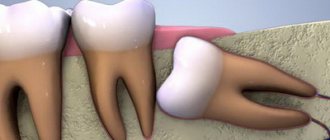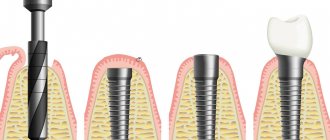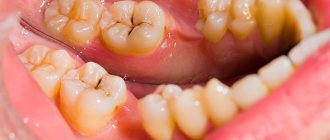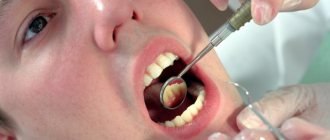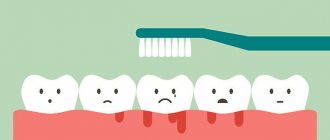16.11.2019
I have a toothache, the pain is unbearable, my gums are red. Outwardly, it’s a completely healthy tooth, but why does it hurt so much?! What happened to your tooth? We'll tell you. What happened is that your tooth suffered from such a nuisance as periodontitis. This disease is not the most pleasant. It takes a long time to treat and can lead to tooth extraction.
So, periodontitis is an inflammatory process at the root of the tooth, the consequence of which is improper treatment, advanced pulpitis or caries, which affects the softer tissue of the tooth (such a tooth looks healthy outwardly, since the walls of the tooth are undamaged).
The first signal of periodontitis is bad breath, periodic increasing pain in the gum area, where an inflammatory process has formed, and in some cases, the formation of a fistula (a canal extending from the root of the tooth outward, outwardly resembling a pale pink abscess). Therefore, if you find at least one of the listed signs in the oral cavity, immediately contact your dentist, since with periodontitis there is a high probability of tooth extraction.
The causes of periodontitis can be different:
- Hypothermia, but this is a rare phenomenon that occurs with weak dental immunity. That is, the teeth already have diseases, such as pulpitis or caries, for example.
- Neglected treatment of pulpitis, if you have started to treat a tooth, then it is better to finish the job, as this can lead to periodontitis and tooth extraction.
- Improperly treated pulpitis. These are cases when nerve endings remain in the tooth canal, not completely removed, the canal is not completely closed with a filling, when the lower part of the root remains hollow and begins to rot, or medicine remains in the tooth root canal.
Treatment of periodontitis of primary teeth in children: indications for removal
In case of periodontitis, the doctor decides whether to remove or treat temporary units.
Removal is indicated if:
- The root of the baby tooth has resolved by more than two-thirds.
- The time unit is excessively mobile.
- The teeth have begun to change, and within a year a new tooth will grow in place of the removed one.
- Periodontitis returned after conservative treatment.
- Destructive changes in bone tissue began near the permanent tooth germ.
- There is a threat of sepsis.
- The child's natural immunity is greatly reduced.
The feasibility of treating periodontitis in temporary children's teeth is assessed by the doctor. If the decision is positive, one or two visits are often enough - drug treatment of the canals and filling are carried out.
Treatment of periodontitis in permanent teeth in children
For permanent teeth, doctors usually choose conservative therapy. It is carried out in several stages:
First visit. Examination, x-ray diagnostics. When the diagnosis is confirmed, the choice of anesthesia is local or in combination with sedation. Neutralization of inflammation. Administration of the drug. Installation of a temporary filling.
Second visit. If there are no complaints, the canals are cleaned of the medicine, washed with an antiseptic, and the tooth is restored.
Control - after a few months, the doctor will ask you to take x-rays to assess the condition of the bone tissue around the tooth.
How modern medicine treats periodontitis
Our dentists have a variety of proven techniques and technologies to successfully treat periodontitis, both acute and chronic. Their choice is influenced by the degree of neglect and coverage area. Treatment is always multi-stage, involving several visits to the dental office, which is due to the complexity of the disease and the inclusion of different structures in the destructive process of tooth tissue, periodontal tissue, bone, and gums. In general, treatment is divided into conservative and, less commonly, surgical.
In some situations, therapeutic treatment using weak current electrophoresis together with medications (potassium iodide solution) may help. The procedure helps eliminate dangerous microorganisms, eliminate inflammation, swelling and pain. But here, too, it is rarely possible to limit yourself to a single treatment session. A course consisting of at least two procedures, with a maximum of 5-6, is required. In a 20-minute session, the drug penetrates into the inflammation site in an amount of at least 0.2 mg. Considering that the impact is local, it is clear that the risk of complications after the procedure is almost zero. After completing the course, the patient is strongly recommended to visit the dentist again after some time so that he can suggest ways to consolidate the beneficial therapeutic effect. Then you will finally be free of this unpleasant disease!
If the disease is chronic, severely neglected and the tooth acts as a source of infection, the doctor may decide to remove the tooth under which periodontitis has developed. Otherwise, you will have to periodically endure exacerbations - the resumption of the inflammatory process. For example, as soon as you become hypothermic or catch a cold, your gums will swell again, become swollen, become sore and, quite possibly, become swollen with gumboil.
Keep in mind that maintaining the integrity of the dental system is the main principle of modern dentistry; removal is performed only in extreme cases. But if this is necessary, then in our center your tooth will be removed absolutely painlessly - thanks to effective anesthetics and surgical technologies.
If the dentist considers it necessary to preserve a tooth, he must carry out a whole range of medical procedures, aiming to destroy putrefactive microbes and prevent the risk of inflammation. Then there is a chance to achieve full compensation for the tooth’s work!
Attention! Therapy for chronic periodontitis depends on the type of inflammation: it can be fibrous, granulating, granulomatous. As a rule, two visits to the doctor are enough to treat fibrous periodontitis. He will clean the canals and install a temporary filling on the first visit, and on the patient’s second visit he will install a permanent one.
Granulating and granulomatous periodontitis are often treated for up to six months. You will have to visit the dentist at least 4 times. Therefore, choose a specialist with whom you are comfortable.
Surgical treatment of periodontitis
Surgical methods are used in cases where the conservative approach is powerless. Also among the indications for visiting a surgeon:
- obstruction of root canals;
- granuloma.
The main method of treating molars is resection of the root apex:
- Pain management - local anesthesia, nitrous oxide, or treatment under sleep sedation.
- Filling the canal with a quick-hardening compound.
- An incision in the gum in the area where the root of the diseased tooth is located.
- Removal of the affected root tip.
- Cleansing the cavity from dead tissue and pus.
- Placement of an antibacterial drug and a bone preparation into the cavity.
- Stitching.
The operation is labor-intensive, but the outcome is positive and allows you to save the tooth.
Conservative direction
The conservative direction includes two treatment methods: therapeutic and physiotherapeutic. In acute periodontitis, the therapeutic method allows you to cure the disease in two visits to the dentist; in the chronic form of the disease, three or four visits to a specialist will be required. The stages of therapy are determined based on the diagnosis of symptoms and the extent of the disease.
As a rule, conservative treatment of periodontitis with a therapeutic method is carried out according to the following regulations:
First visit to the dentist
- Examination of a patient by a dentist.
- X-ray examination of the disease area.
- Identifying all the nuances of the patient’s bone tissue structure, prescribing a method of therapy, preparing the patient for the procedure.
- Local anesthesia.
- Opening the causative tooth, opening access to the dental canals.
- Expansion of the diameter of the channels, treatment with antiseptic drugs.
- Placement of a special temporary filling (antiseptic) into the dental canals.
- Prescribing painkillers and antibacterial drugs for self-administration.
Second visit to the dentist (usually scheduled 2-3 days after the first)
- Local anesthesia.
- Removing a filling from a root canal.
- Treatment of the dental canal with antiseptic drugs.
- Canal filling.
- X-ray control.
- Placing a permanent filling.
Treatment of periodontitis using the physiotherapeutic method comes down to one or two visits to the doctor and the following work:
- Intrachannel electrophoresis.
- UHF.
- Laser therapy.
Physiotherapeutic techniques are applicable only for the chronic form of the disease.
How periodontitis of primary teeth affects the rudiments of permanent teeth
The health of the molars directly depends on the condition and integrity of the primary teeth. Untimely treatment or ignoring periodontitis has a serious impact on the formation of rudiments and the formation of a permanent dentition. Dentists speak of three phases of molar development and the consequences of periodontitis:
- Formation of the tooth germ - the root is destroyed and dies.
- Crown formation – enamel hypoplasia or complete degradation and absence of a tooth.
- Root formation – a mobile permanent tooth grows, which is easily injured and quickly falls out.
Treatment in our clinic
To get rid of the disease efficiently, it is necessary to have a good organization of the entire process of working with the patient: from diagnosis to treatment.
In our clinic, each specialist is highly qualified, and all dental procedures are performed using the latest tools and equipment. Thus, in our clinic we offer to eliminate all the consequences of periodontitis at the most comfortable and safe level for the patient. According to statistics, with timely treatment, in 97% of cases it is possible to qualitatively eliminate all inflammatory processes in tissues and restore chewing function.
Reviews from parents and impressions of children
Suvorova Anastasia
Periodontitis is a terrible diagnosis, and it came to us unexpectedly. Who knew that a simple fall would lead to such severe inflammation in the mouth. Misha just fell on the swing. And then a week later he began to cry, refuse to eat, and complain of tooth pain. The doctor from Aza&Buka made a diagnosis and suggested starting treatment immediately. In one go, the tooth was saved. The treatment was fun, with cartoons. With a creative and positive approach. Misha is happy, and the tooth no longer hurts.
I put Aza&Buka:
5
Misha
Alexander
Alice had to have her baby tooth removed due to periodontitis. At Aza&Buka they took an x-ray and saw that the new tooth was ready to grow. The patient removed it and after a few weeks a permanent one grew. Healthy! Thank you for your professional approach and for not needlessly tormenting the child with treatment.
I put Aza&Buka:
5
Alice
Veronica Stepanova
Pasha was diagnosed with periodontitis of a molar tooth. The reason is poor quality treatment of pulpitis in one of the clinics near Moscow. They were treated surgically under good anesthesia. Long enough, because carefully and scrupulously. They cleaned everything out of the affected cavity and scheduled an x-ray control in a month. It wasn't very expensive for such a service!
I put Aza&Buka:
5
Pasha
Chronic periodontitis, symptoms of the disease
Acute periodontitis turns into chronic periodontitis, the symptoms of this disease are very mild. Differential diagnosis allows you to establish the form of the disease, as well as prescribe appropriate conservative or surgical treatment methods.
Still, there are some clinical signs that may indicate chronic periodontitis; symptoms are characterized by: slight pain, a feeling of swelling of the gums, an unpleasant sensation while chewing.
At advanced stages, this disease has more deplorable symptoms: gum subsidence, tooth mobility under mechanical influence, and the appearance of purulent fistulas.
It is worth emphasizing that despite the mild symptoms and lack of particular discomfort, the chronic form is more dangerous than the acute one. If conservative or surgical treatment methods are not used, chronic periodontitis can lead to tooth loss; moreover, this process can spread to neighboring teeth.
It is precisely because of the absence of symptoms that patients most often seek help when the disease is already in an advanced state or in an acute form and requires urgent use of conservative and surgical treatment methods.
Answers to popular questions
Anesthesia for dental treatment for children: what consequences can we expect?
Children's anesthesia for dental treatment is safe, serious consequences are excluded. After recovering from anesthesia, the child may experience slight discomfort, so we leave children in the clinic for several hours and monitor them.
Indications for removal of baby teeth in children?
Removal of children's milk teeth is necessary in case of severe caries or pulpitis, inflammation at the root, or splitting or cracking. People also come to me with very loose teeth, as prescribed by the orthodontist, or if an extra tooth is growing.
Is treatment of children's baby teeth really necessary?
Treatment of baby teeth is a necessity. If you don't do this, you can lose your teeth and have problems with your bite. Or permanent units will be at risk of caries. But even worse is the pain and discomfort experienced by a child with bad teeth. At the Aza&Buka clinic, teeth are treated without pain and even without drilling - with ozone, laser, and minerals.
Is painless dental treatment possible for children?
Is painless dental treatment possible for children?
At the Aza&Buka clinic, teeth are treated without pain. We use the best anesthesia options, as well as nitrous oxide treatments. Usually the children watch cartoons while I treat caries in baby teeth.
Did not find an answer to your question?

